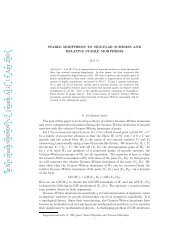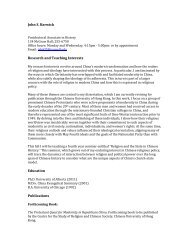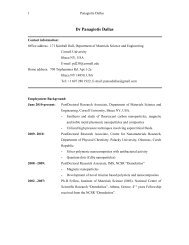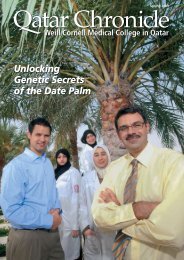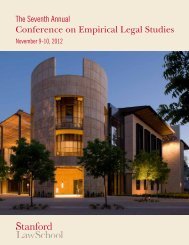IBC Incident Reporting Procedures - Institutional Biosafety Committee
IBC Incident Reporting Procedures - Institutional Biosafety Committee
IBC Incident Reporting Procedures - Institutional Biosafety Committee
Create successful ePaper yourself
Turn your PDF publications into a flip-book with our unique Google optimized e-Paper software.
<strong>Institutional</strong> <strong>Biosafety</strong> <strong>Committee</strong>Cornell University395 Pine Tree RoadSuite 320Ithaca, NY 14850t. 607-255-7219f. 607-255-0758email. cu_ibc@cornell.edu<strong>Procedures</strong> For <strong>Reporting</strong> And Managing <strong>Incident</strong>s Involving AccidentalRelease/Exposures or Personnel Contamination while using Recombinant Or SyntheticNucleic Acid (r/sNA) Molecules** or Other Biohazardous Materials1. Types of Reportable <strong>Incident</strong>s:Needlestick,Sharps injuries (e.g., scalpel, broken glass)Contact with eyes, nose, mouth, open wounds, cuts, scratchesInhalation of aerosolized material (e.g., large spill outside of biological safety cabinetagents at BSL-2, BSL-3)Bites/scratches from infected animalsBites from animals with introduced r/sNA moleculesRelease or loss of transgenic plants, animals or materials** Accidental spills and personnel contamination resulting from research involvingrecombinant and synthetic nucleic acids will be handled in accordance with the SectionIV-B-2-b-(6) of the NIH Guidelines that govern this type of research.2. Immediate ActionTo report any On-Campus EmergencyCornell Police at 911 on a Cornell Phone, 255-1111 on a Cell Phone2.1. If personnel exposure to infectious agents or r/sNA Splash to eyes: Flush with water at eyewash for 5 minutes Needlesticks, cuts, scratches, animal bites, skin contact: wash area with soap andwater for 5 minutes Perform first aid, if applicable Notify supervisor Contact Gannett Health Services, Occupational Medicine (255-6960) as soon aspossible after an exposure or if you develop symptoms suggestive of exposure to thebiohazardous agent to determine if medical evaluation is indicated. After hours seekevaluation at Cayuga Medical Center Contact the <strong>Institutional</strong> <strong>Biosafety</strong> officer within 24 hours.(fac2@cornell.edu or 254-4888) Submit a report to the Cornell University Injury/Illness/Exposure Report,https://rmps-prod.hosting.cornell.edu/accinj/Cornell <strong>Institutional</strong> BioSafety <strong>Committee</strong> – Approved 9-10-2013 Page 1
3.4. <strong>Institutional</strong> <strong>Biosafety</strong> <strong>Committee</strong>Review the incident and set measures to mitigate the problem and preclude itsreoccurrence.Determine if any actions need to be taken with regards to suspension of researchactivities if outcomes are not satisfactory.If further action is required, the Director of ORIA will work with the Chair of the <strong>IBC</strong>,the BioSafety Officer and other university officials to manage the resolution.3.5. Office of Research Integrity and Assurance (ORIA)In consultation with the University BioSafety Officer and the Chair of the <strong>IBC</strong>,determine if the incident constitutes a significant problem with or violation of the NIHGuidelines or a significant research-related accidents or illnesses, and if reporting to theNIH or other regulatory (Local/ State/Federal ) agencies is required. Consult with theNIH if needed in making this determination.Collaborate with the University <strong>Biosafety</strong> officer, the PI and any affected researchpersonnel to conduct an investigation of the incident, and ensure that corrective actionsare appropriate.If reporting to the NIH is required, prepare an incident report per the NIH requirements.Consult with the PI, researcher, <strong>Biosafety</strong> Officer and Chair of the <strong>IBC</strong> to ensure that thereport is accurate and complete.If necessary, report to the <strong>Institutional</strong> Official and NIH/OBA within 30 days, unless the<strong>IBC</strong> determines that a report has already been filed by the Principal Investigator. The following types of accidents require immediate reporting:1...1. Spills or accidents occurring in high containment (BL3) laboratories resultingin an overt or potential exposure. (NIH Guidelines Appendix G-II-C-2-q)1...2. Spills or accidents in BL2 laboratories resulting in an overt exposure. (NIHGuidelines Appendix G-II-B-2-k)Send reports to NIH/OBA at Office of Biotechnology Activities, National Institutes ofHealth, 6705 Rockledge Drive, Suite 750, MSC 7985, Bethesda, MD 20892-7985(20817 for non-USPS mail), 301-496-9838, 301-496-9839 (fax) or oba@od.nih.gov.3.6. Gannett Occupational MedicineProvide medical careMaintain medical recordsIn cases of communicable disease, report to the county health department and communicate withappropriate resources (e.g., infectious disease consultant, CDC)Cornell <strong>Institutional</strong> BioSafety <strong>Committee</strong> – Approved 9-10-2013 Page 3
4. Contact information for reportingCornell University Injury/Illness/Exposure Reporthttps://rmps-prod.hosting.cornell.edu/accinj/<strong>Institutional</strong> <strong>Biosafety</strong> Officer: Frank Cantone607-254-4888 or fac2@cornell.edu<strong>IBC</strong> Administrator (ORIA): Debra Dwyer607-255-7219 or dad3@cornell.eduORIA Director: Amita Verma607-255-2214 or av234@cornell.eduGannett Occupational Medicine607-255-69605. NIH Guidelines For Research Involving Recombinant Or Synthetic Nucleic AcidMolecules (NIH Guidelines) (Excerpt relevant to requirements related to accidental Spills,personnel contamination or exposure resulting from recombinant or synthetic nucleic acidmolecule research).On behalf of the institution, the <strong>Institutional</strong> <strong>Biosafety</strong> <strong>Committee</strong> is responsible for:Section IV-B-2-b-(6). Adopting emergency plans covering accidental spills andpersonnel contamination resulting from recombinant or synthetic nucleic acid moleculeresearch.Note: The Laboratory Safety Monograph describes basic elements for developingspecific procedures dealing with major spills of potentially hazardous materials in thelaboratory, including information and references about decontamination and emergencyplans. The NIH and the CDC are available to provide consultation and direct assistance,if necessary, as posted in the Laboratory Safety Monograph. The institution shallcooperate with the state and local public health departments by reporting any significantresearch-related illness or accident that may be hazardous to the public health.Section IV-B-2-b-(7). <strong>Reporting</strong> any significant problems with or violations of the NIHGuidelines and any significant research-related accidents or illnesses to the appropriateinstitutional official and NIH/OBA within 30 days, unless the <strong>Institutional</strong> <strong>Biosafety</strong><strong>Committee</strong> determines that a report has already been filed by the Principal Investigator.Reports to NIH/OBA shall be sent to the Office of Biotechnology Activities, NationalInstitutes of Health, 6705 Rockledge Drive, Suite 750, MSC 7985, Bethesda, MD 20892-7985 (20817 for non-USPS mail), 301-496-9838, 301-496-9839 (fax).As part of this general responsibility, the Principal Investigator shall:Section IV-B-7-a-(3). Report any significant problems, violations of the NIH Guidelines,or any significant research-related accidents and illnesses to the Biological Safety Officer(where applicable), Greenhouse/Animal Facility Director (where applicable), <strong>Institutional</strong><strong>Biosafety</strong> <strong>Committee</strong>, NIH/OBA, and other appropriate authorities (if applicable) within30 days. Reports to NIH/OBA shall be sent to the Office of Biotechnology Activities,Cornell <strong>Institutional</strong> BioSafety <strong>Committee</strong> – Approved 9-10-2013 Page 4
National Institutes of Health, 6705 Rockledge Drive, Suite 750, MSC 7985, Bethesda,MD 20892-7985 (20817 for non-USPS mail), 301-496-9838, 301-496-9839 (fax);NIH FAQ’s about <strong>Incident</strong> <strong>Reporting</strong>The NIH FAQ about incident reporting state the following: The NIH Guidelines for ResearchInvolving Recombinant or Synthetic Nucleic AcidMolecules (NIH Guidelines) states that "...any significant problems, violations of the NIHGuidelines, or any significant research-related accidents and illnesses" must be reported to NIHOBA within 30 days. Certain types of accidents must be reported on a more expedited basis.Spills or accidents in BL2 laboratories resulting in an overt exposure must be immediatelyreported to NIH OBA. Spills or accidents occurring in high containment (BL3 or BL4)laboratories resulting in an overt or potential exposure must be immediately reported to NIHOBA.References:NIH Guidelines for Research Involving Recombinant or Synthetic Nucleic Acid Molecules<strong>Biosafety</strong> in Microbiological and Biomedical LaboratoriesCornell <strong>Institutional</strong> BioSafety <strong>Committee</strong> – Approved 9-10-2013 Page 5




